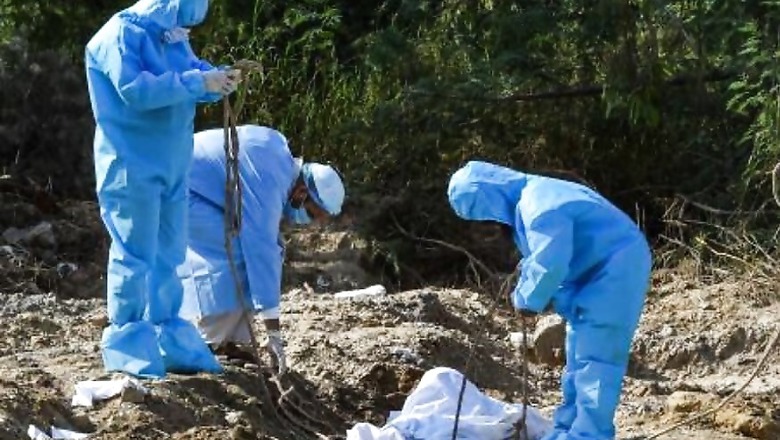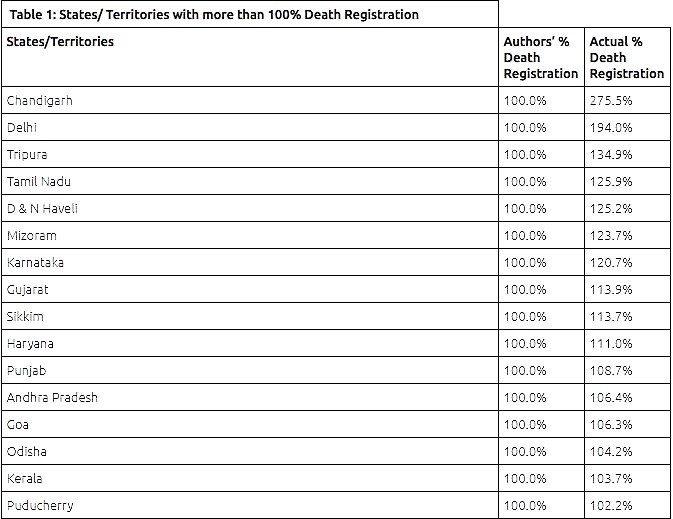
views
In the early days of the COVID-19 outbreak in India, ‘health experts’ went studio-hopping, penning lurid opeds in between, predicting a grim scenario of millions of Indians perishing in the pandemic. Almost halfway into August, India is nowhere near resembling the grim picture that had been painted; it has one of the lowest fatalities per million among populous countries. It would appear that rather than admit they had got their sums wrong, the ‘experts’ have decided to brazen it out by arguing that there has been ‘severe under-reporting’ of COVID-19 deaths.
Many publications have offered a platform to these ‘experts’ to float droll theories of state conspiracy to suppress data on COVID-19 fatalities. Such laughable exercises have been proven to be based on bad assumptions, lack of understanding of ground realities or, simply, confirmation bias.
Some degree of underreporting of deaths and cases is inevitable in weak health systems like ours and this is true for countries across the world. This is often temporary and the numbers are reconciled as government systems catch up with data collation. This basic fact has failed to restrain those prone to alarmism. They have been claiming, without any basis, that a grave “invisible disaster” is sweeping through India, that the true scale of the human tragedy has been hidden from the public by the Government.
Regrettably, mainstream media has thrown caution to the wind while publishing fact-free analyses, commentary and opinion spun around dubious datasets emerging from graveyards and crematoria across cities.
With COVID-19 spreading to almost all districts in India, barring three districts of Arunachal Pradesh, there has been a spate of speculative articles anticipating or assuming a rural catastrophe, chronicling severe systematic ‘undercounting’ of deaths. Things have come to such a pass that the more bizarre the claims of ‘experts’, the greater the chances of finding a mainstream media platform to air their views.
An article published in The Hindu on 10th August eloquently demonstrates this point. It’s a game of ‘guesstimates’ where fiction competes with fiction and it is fiction that wins: As on 31st July, The Hindu informs us, a shocking 1.89 lakh people may have died across India due to COVID-19, not 35,747 as recorded by the Government of India.
The commentary in the Hindu, penned by two medical researchers linked to the India COVID Apex Research Team (iCART), a group of experts from AIIMS, IISER, IIT and Harvard University, seems to mirror a certain analysis template made famous by various international media platforms, relying heavily on the fact that on the average only 22% of registered deaths in India are medically certified. This template, which is the leitmotif of the current infodemic of spurious articles on COVID-19 deaths in India, assumes that since medical certification of causes of deaths is very low at around 20%, the official data on pandemic deaths, by extension, is an underestimation by the same degree. So, for every COVID-19 death reported by the Government, the actual number of deaths would be five.
The analysis that stems from such stunningly simplistic assumptions and untenable claims is fairly simple too: the authors tabulate the number of State-wise deaths as on 31st July.
Separately, the proportion of actual medically certified deaths among reported deaths for respective States is calculated for the latest available year. This number is used to arrive at a “multiplication factor” reflecting the proportion which will help overcome the current gap in overall medical certification of deaths for a particular state. For example, if a state has a proportion of 20% deaths that are medically certified, the “multiplication factor” will be 100 divided by 20 which is equal to 5. This “multiplication factor” is then absurdly applied on COVID-19 fatalities across states. This is basically how the authors of the analysis published by the Hindu arrived at their gobsmacking figure of 1.89 lakh deaths due to COVID-19.
After claiming that India had the highest number of COVID-19 deaths in the world as on 31st July, the authors use their deeply flawed (some would say spurious) guesstimate to make international comparisons of deaths per million population. Which brings them to the frightening conclusion that India’s COVID-19 death rate is actually 128 deaths per million, not 26 per million as reported by the Government. Their simplicity of analysis gives the lie to their claim: There are glaring gaps in the Hindu’s speculative piece, including deliberate fudging of data.
The authors begin by setting up the context in a by-now-familiar way to ensure that readers are primed about the hopeless inefficiencies and delays of the Indian health information ecosystem. They claim with sweeping authority that the latest report of medical certification of cause of death (MCCD) is available for 2017, implying a long delay in the compilation and reporting of data by Government. While doing so, they gloss over the fact that MCCD report for 2018 was published last month. Despite 2018 data being available, the analysts stick to 2017 data.
Second, and more seriously, the authors deliberately distort their analysis by putting a virtual cap on the proportion of actual medically certified deaths among estimated deaths at the state level.
As discussed elsewhere, in many Indian states, cities with medical hubs tend to have a higher number of registered deaths – sometimes well beyond the estimated number of deaths for the residents of the State. As a consequence, many states end up with more than 100% death registration. The authors of the article cap this figure at 100%. This means that states like Delhi, Tamil Nadu, Karnataka, Gujarat, Andhra Pradesh, Haryana, Punjab and Kerala, with much more than 100% death registration, are treated as having only 100% death registration (Table 1).

Source: http://crsorgi.gov.in/web/uploads/download/crs2018_20072020_approved.pdf
In brief, while less than ideal death registration is reflected as is in the analysis, more than ideal death registration – purportedly resulting from residents of low performing states in the neighbourhood visiting states with better healthcare facilities – has been deliberately depressed to keep the “multiplication factor” high.
It is to be noted that part of the reason why low performing states have a low percentage of deaths registered and medically certified is because many seriously ill residents travel to medical hubs in nearby states. The fact that it is a zero-sum game between the states is ignored, while capping the death registration figure. Such intellectually dishonest means to inflate the state level COVID-19 death estimates is not without reason: Most COVID-19 fatalities till date are from states which have close to or more than 100% death registration.
Let’s take the example of Delhi. Even if we were to assume that the methodology of the analysis published in the Hindu is sound (which it is not), the actual “multiplication factor” for Delhi should have been about half of what the authors’ specious calculation has made it out to be. The authors appear to have willfully played ducks and drakes with Delhi data and put 100% instead of 194%. Had they not done so, the estimated number of COVID-19 fatalities would’ve been less than the recorded numbers by their own calculation. Of course, there no analysis worth publication by the mainstream media in that case. No arbitrary capping would have meant dramatic changes in the estimated number of COVID-deaths for states like Tamil Nadu, Karnataka, Gujarat, Andhra Pradesh, Haryana, Punjab and Kerala too.
The biggest flaws in the so-called analysis, however, are the core methodology and assumptions. The authors lazily assume that the same high “multiplication factor” for the overall deaths can be used for specific disease conditions. They neither accept nor concede the fact that certain disease conditions can have relatively high proportion of medically certified deaths. For example, deaths related to cancer, accidents and suicide are more likely to be reported and have a medical certification than what are referred to as ‘natural deaths’.
When the whole Indian health system is repurposed to capture the spread, contain the infection and treat cases of COVID-19, death reporting, as well as medical certification, would be considerably higher than the average of all deaths, particularly in urban areas which have accounted for most pandemic deaths and cases till now. In addition, spatial and temporal analyses that assume that conditions have not changed with the arrival of COVID-19 will always give fallacious results.
In an earlier piece, this author had observed that India has a weak health surveillance system, vibrant democracy, sloppy dissemination of official data, an often hyperactive media and very few health editors in mainstream media. This particular article in the Hindu underlines the need for honesty, editorial oversight and fact-checking by our mainstream media platforms. It is sad to see researchers sliding from healthy scepticism of Government data into speculative and bogus data analysis sans evidence. This borders on fake news and serves no other purpose than to fuel conspiracy theories.
On 2nd August, around 200 experts urged the Office of the Registrar General and Census Commissioner of India to release the data for the number of registered deaths from the civil registration system as this can help guide policy to battle the COVID-19 pandemic. That was a step in the right direction. What is palpably a leap in the wrong direction is the parallel epidemic of dishonest and unscientific analyses and alarmist commentary in the mainstream media in the midst of a national pandemic emergency.
The Hindu perhaps chose to publish the piece to be a step ahead of the Washington Post and the New York Times which have been laboriously making similar claims unfounded in truth. They should, however, consider retracting this piece, or else zombie statistics and fake analyses would find legitimacy.
The article first appeared in ORF.

















Comments
0 comment